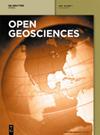Dynamic analysis of MSE wall subjected to surface vibration loading
IF 1.3
4区 地球科学
Q3 GEOSCIENCES, MULTIDISCIPLINARY
引用次数: 0
Abstract
Extensively used Mechanically Stabilized Earth (MSE) walls in Rail Transportation System (RTS) are vulnerable to surface vibrations generated by moving vehicles. Hence, it is necessary to consider the effects of surface vibrations during the design of MSE walls for RTS. Steel-reinforced panel-type MSE walls are shown to perform well during vibration loading, but costly steel materials have led to greater reliance on affordable and readily available geosynthetics for reinforcement. Limited research exists on the behavior of panel-type MSE walls with geosynthetics considering RTS-induced vibrations frequencies. Thus, this study employs Finite Element software PLAXIS 3D to simulate the impact of surface vibration frequencies on panel-type MSE walls. The qualitative study encompasses two reinforcement cases (geogrids and steel strips) of 4 m MSE wall height and four harmonic loading frequencies representing RTS-induced surface vibrations for simulation. The dynamic responses of MSE wall are presented in terms of lateral wall displacements and lateral earth pressure distributions. Furthermore, the distributions of tensile strain and the identification of potential slip surface locations are presented. The findings indicated that MSE wall and reinforcement responses are governed by RTS-induced vibrations and fundamental frequency of backfill soil. This highlights the need for consideration of both the fundamental frequency of the backfill soil and RTS-induced vibrations in the design of MSE walls.承受表面振动荷载的 MSE 墙体的动态分析
轨道交通系统(RTS)中广泛使用的机械稳定土(MSE)墙很容易受到行驶车辆产生的表面振动的影响。因此,在设计轨道交通系统的机械稳定土墙时,有必要考虑表面振动的影响。钢筋加固的板式 MSE 墙在振动加载时表现良好,但钢筋材料成本高昂,因此更多地依赖于价格低廉、易于获得的土工合成材料进行加固。考虑到 RTS 引起的振动频率,对使用土工合成材料的板式 MSE 墙体行为的研究十分有限。因此,本研究采用有限元软件 PLAXIS 3D 来模拟表面振动频率对板式 MSE 墙体的影响。定性研究包括两种加固情况(土工格栅和钢带),MSE 墙高 4 米,模拟四种代表 RTS 引起的表面振动的谐波加载频率。MSE 墙的动态响应表现为墙体侧向位移和侧向土压力分布。此外,还介绍了拉伸应变的分布和潜在滑移面位置的识别。研究结果表明,MSE 墙体和加固反应受 RTS 引起的振动和回填土基频的影响。这突出表明,在设计 MSE 墙体时,需要同时考虑回填土的基频和 RTS 引起的振动。
本文章由计算机程序翻译,如有差异,请以英文原文为准。
求助全文
约1分钟内获得全文
求助全文
来源期刊

Open Geosciences
GEOSCIENCES, MULTIDISCIPLINARY-
CiteScore
3.10
自引率
10.00%
发文量
63
审稿时长
15 weeks
期刊介绍:
Open Geosciences (formerly Central European Journal of Geosciences - CEJG) is an open access, peer-reviewed journal publishing original research results from all fields of Earth Sciences such as: Atmospheric Sciences, Geology, Geophysics, Geography, Oceanography and Hydrology, Glaciology, Speleology, Volcanology, Soil Science, Palaeoecology, Geotourism, Geoinformatics, Geostatistics.
 求助内容:
求助内容: 应助结果提醒方式:
应助结果提醒方式:


